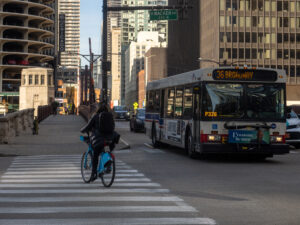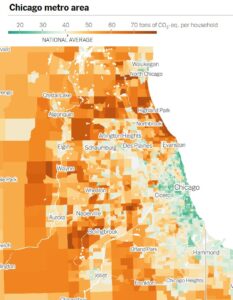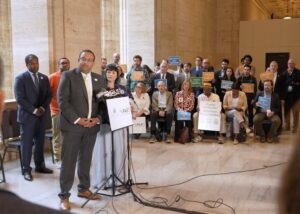CTA L train
April 29, 2024
The Planet Depends on Buses & Trains
Improving transit funding and governance is key to meeting our Illinois climate goals

CTA bus, Chicago
The CTA, Pace, and Metra will run out of money sometime in 2025 or 2026. Ridership plummeted during COVID, and today’s new hybrid work culture has resulted in far fewer commutes and far lower farebox revenues. Ridership is rebounding, but not as rapidly as other cities, and not enough for what’s needed. Unless the state acts to fill in the billion-dollar hole, addressing the resulting “fiscal cliff” will require massive layoffs and draconian service cuts which will leave customers nostalgic for the “ghost” buses and trains of today.
While this would obviously be bad news for commuters, consumers, and employers, it would also be bad for the environment. Here’s why, and what ELPC is doing to fix it:
Public Transit is Good for the Environment
Transportation is the leading source of climate change pollution, and most of that comes from people driving cars. While other sectors are getting cleaner, transportation emissions continue to grow. In Chicago, for example, transportation-related emissions grew by 43% per person between 1990 and 2017. This happened even though cars continue to increase fuel efficiency because per capita vehicle miles traveled (VMT) continue to increase. People keep driving: more distance, more often.

SOURCE: https://www.cmap.illinois.gov/data/greenhouse-gas-inventory
It could be worse. The average Dallas-Fort Worth resident generates about 50% more on-road emissions that the average Chicagoan. And Alabama residents drive almost twice as much as Illinois residents do. Why? Because they don’t have our transit system, which, in turn supports our denser, walkable, bikeable land use.
On average, taking the CTA results in 60% less carbon pollution than driving a car by yourself. [i] And on the margins, it eliminates all your carbon pollution since you are just one more passenger on a bus or train that was already traveling. Either way you look at it, getting people out of cars and onto buses and trains reduces carbon pollution. By the same token, allowing transit to deteriorate would move people from transit to cars and exacerbate pollution.
As RTA Chairman Kirk Dillard noted, “Chicagoans need to know that one of the best ways to immediately and positively impact our air quality and reduce our greenhouse gas emissions is to choose public transportation. With more than one million trips per day, emissions from public transit vehicles make up less than 2% of the region’s transportation emissions. Passenger vehicles such as your car, truck, or SUV account for 59%.”
Transit is Essential for Chicagoland

SOURCE: https://www.nytimes.com/interactive/2022/12/13/climate/climate-footprint-map-neighborhood.html
In the long term, public transit is even more important for meeting our climate goals. Dense urban dwellers produce far less carbon than their suburban and rural counterparts. They are close to many necessities like corner stores, pharmacies, and schools, which may be a long drive away in more spread-out communities. Urban residents not only drive less but live in smaller homes and apartments that are more efficient to heat and cool. And they support local businesses with similarly small carbon footprints. A Chicago resident generates less than half the carbon pollution as a resident of Will County, for example. But urban living isn’t feasible without public transit. It’s the most space-efficient way to move people to their destinations, and cities are tight on space. Our economy cannot grow without a smart, efficient way to move people around.

Metra Train, Mount Prospect, IL
Even among our suburbs, communities built around a train station with a walkable downtown core have lower climate impact than those without. Many suburban residents depend on transit as a cost-effective and climate-friendly transportation solution. 74% of Metra riders have a car available and choose Metra over driving, so if Metra were not available it would certainly add thousands of cars to the road. Some of the strongest Pace and Metra ridership growth is now among off-peak and inter-suburban travel, showing suburban riders are increasingly seeking to use transit for trips beyond commuting. Imagine what ridership we could unlock with a more interconnected and forward-thinking system!
The Metropolitan Mobility Authority Act

Source: https://www.cmap.illinois.gov/programs/regional-transit-action
Northern Illinois cannot meet its climate goals without a robust public transit system. That requires two things: significant new funding and governance reform.
Chicago is not alone in facing a fiscal cliff – commuting patterns have changed everywhere due to COVID. But Chicago receives far less state support for its transit operations than peer cities.

Pace bus to Wilmette
Chicago also faces the challenge of a byzantine governance structure, with four separate agencies controlling transit. State Senator Villivalam and Representative Delgado have introduced legislation to combine all four agencies into a single Metropolitan Mobility Authority. Instead of four government agencies (RTA, CTA, Pace, Metra) competing for funds, duplicating services, and ignoring decades-old requirements to integrate fares, a unified Authority would oversee all bus, rail, and paratransit operations and respond to the diverse needs of our municipalities, counties, and the state. This new Authority would be charged with providing:
- Exceptional Service – Fund the system and modernize governance to support expanded, fast, frequent, reliable transit services that connect important destinations.
- Safe and Comfortable Rides: Implement policies, like transit ambassadors, that make transit safe, secure, & clean.
- Unified Regional Vision: Streamline operations and reduce overlapping, competing transit service for seamless transfers throughout the 6-counties of Northeast Illinois.
- Integrated and Affordable Fares: Integrate one fare system across all Chicagoland transit providers; provide affordable fares and passes for low-income riders.
- Desirable Destinations Within Reach: Incentivize transit-supportive development to foster vibrant, healthy communities with housing and amenities accessible via transit.

State Senator Villivalam & Representative Delgado announce the Metropolitan Mobility Authority Act alongside coalition supporters
ELPC and a broad coalition of environmental, public health, and business leaders are calling for the bold legislation needed to save and improve our transit system. Let’s hope Springfield gives this legislation the support it deserves. Our environment is counting on it.
Take Action
Tell your Illinois Senators & Representatives that you value sustainable public transportation.
Read Factsheets on Legislation
[i] National Academies source. Page 75: 0.23 kg/mile vs 22.2 mpg average car with emissions at 8.887 kg/mile EPA Source.


